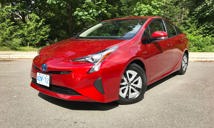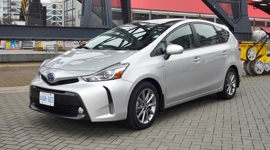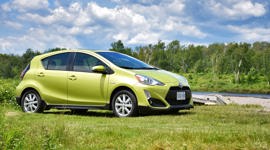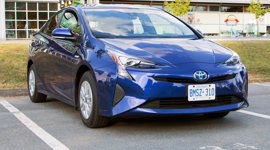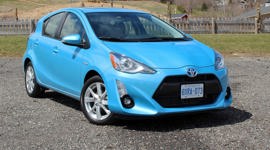 AutoTrader SCORE
AutoTrader SCORE
-
EXTERIOR STYLING6/10
-
INTERIOR8/10
-
PERFORMANCE6/10
-
COMFORT8/10
-
FUEL ECONOMY10/10
With the adaptive cruise set to 105, a clear and sunny four hours ahead, a little Rise Against on the stereo, and the A/C keeping your correspondent crisply chilly on a 30+ degree day, a smug sense of satisfaction arose while driving the new-for-2016 Prius.
An on-screen display flickers away in the lower edge of your vision, with arrows connecting the motor, engine and wheels, back and forth, as electricity is generated, stored, dispatched, and blended with gasoline power.
Used for a cruise, Prius is comfort first, dense and solid, and not excessively squishy. It’s a more comfortable ride than the Honda Civic Touring. Highway steering feel is decently locked-on, slightly heavy, and a touch on the quick side. The gooey, syrupy steering I noted in past Pruis test drives isn’t in attendance, and the steering and handling balance now feel like somebody spent some time fine-tuning one off of the other.
Squeeze the throttle to beat that Buick to the end of the passing lane, and the Prius oozes by, smoothly, responsively, and with virtually no audible sound from beneath, as gas and electric output are ramped up and blended. It’s not fast, but it glides ahead, smoothly as can be, the instant you request it. From lower speeds, the electric torque meets heavy throttle inputs with a surprising forward leap that calls the market’s latest punchy little boosted four-cylinder cars to mind, but without the lag. Many compacts aren’t this smooth, or quiet, or fast to respond.
But you cruise, surrounded by tall windows, with the high-tech control consoles and display screens mounted low, to preserve your outward view. It’s relatively quiet until beyond 110 km/h, and the seats are thickly padded, and the cabin spreads widely around you. And even some 100-plus kilometres into a drive, the gas gauge still reads FULL.
So it’s comfortable. Relaxing. Easygoing. Nicely dialed in. A comfy cruiser that’s excellent on fuel. Not to mention, feature content is highly relevant, and pricing is reasonable, too. And Prius steers, accelerates and rides with the same characteristics as virtually any other well-done mid-sized car.
Even getting in and out is a cinch. Front doors are big, and open widely on SofTex leather seats that enable easy sliding in behind the wheel. Rear seat space is adult-adequate, though a smaller door opening and declining roofline create a more confined space with limited outboard elbow room, and headroom quickly diminishing for those over 5’11”.
A downsized and powered-up battery facilitates a full-function cargo area, complete with a box-like space that’ll fit four suitcases, a week’s worth of groceries, or a weekend’s worth of camping gear for a couple. There are folding seats, in case you need to bring a ladder with you, or if cases of Cottonelle are on sale at Costco.
A wireless cellular recharging pad sits front and centre in the gloss-white centre console, itself serving as the cabin’s central showpiece. Your writer wonders how long the gleaming finish will survive daily use, and though it’s a unique looking bit of kit, some passengers said it reminded them of a bidet. The shifter is a little weird, too, and looks like the joystick on a video game controller. It’s all a little quirky in some facets of style and functionality, but the designers have done a bang-on job of keeping Prius’s high-tech new digs looking remarkably tidy, organized, and simple.
And that cabin is just one of many, many enhancements. Existing owners, says Toyota, will find the latest model to be a significant step up from a past Prius. It’s easier on fuel. More responsive. More refined. Toyota’s also hoping that, by making this new Prius drive even more like every other car, they’ll attract new and apprehensive shoppers to the world of hybrid motoring, too. Hybrid cars have been improving in many recent years, with the Prius largely leading the charge. And this new one marks yet another step ahead.
Where former Prius models (and other hybrids in general), often operated with a shifty squirminess as electric and gas propulsion were combined and switched, the Prius’s latest driveline is seamless. Like, totally seamless. Other than just two occasions on my 1,300 km test drive where the Hybrid Synergy Drive system failed to anticipate my next move, you just press the throttle, and the Prius glides ahead. No squirm. No lurch. No shifting gears, since there aren’t any. Just a swelling up of momentum. And with the new powertrain built to be quieter and smoother, it takes plenty more throttle before you hear or feel the 1.8L gas engine at all. Toyota’s even made strides to reduce the negative effects of winter temperatures on fuel efficiency.
Some noises, or lack thereof, give it away a little. There’s no starter motor, so Prius fires up in silence. An occasional high-pitch whirr from the electric motor seeps in too, at times. But for the way it responds and feels, the new Prius virtually doesn’t feel like a hybrid at all.
Other notables include the vivid and crisp Head-Up Display, complete with on on-screen ECO coach, which helps drivers visualize the most fuel-efficient throttle application. The central command system falls behind some competitors in terms of graphics and resolution, though it’s logical and responsive and easily navigated without frustration. The standard LED lighting system is also above average: with a great cut-off line, even light output, good reach, good peripheral illumination, and crisp colour.
The best thing? I achieved silly-good mileage, in less-than-ideal conditions, without even trying. On my watch, which included minimal use of the fuel-saving ECO mode, minimal in-town city driving where hybrids typically operate most efficiently, and minimal changes to my moderately heavy-footed driving habits, I measured 4.4 L/100 km. To compare, a three-cylinder Mini Clubman, which I thought was ultra-thrifty, did 7 L/100 km on a similar drive. So, Prius is hilariously good on fuel.
Complaints? Just two. Some automakers have made strides towards a more natural brake-pedal feel in hybrid cars, which typically don’t have a natural brake pedal feel, because of how hybrid cars brake.
The Chevrolet Malibu Hybrid is one example. Prius, on the other hand, still has brakes that feel a little funny and artificial, at least until you get used to them, which I never really did. They perform with appreciable urgency when needed, though the feel at the pedal itself is still pure hybrid. Second, there’s a back-up beeper that engages urgently when reverse is selected, though it’s located inside the car, and the incessant beeping in the cabin makes backing up an unpleasant experience.
The latest Prius is so good to drive, in so many ways, that it left your writer wondering about the styling. This is a weird-looking car, plain and simple. And sure: it has to look this way, to be as aerodynamic as it is. And some shoppers don’t care how their car looks. And a few more may even find it charming, since it looks like the love child of R2D2 and a grasshopper. Still, I wonder if Prius would be more appealing to the masses if it looked less out-of-this-world.
After all, even after years on sale, and many advances, hybrid cars still account for only a teensy fraction of car sales. And of any hybrid I’ve driven, this is the one that feels most like an opinion changer for the hesitant.
Ultimately, if you can digest the styling, Prius delivers many of the traits in highest demand for cars today. It’s comfortable. Flexible. Nice to drive. Maneuverable. Responsive. Even quick, in the right situation. It has the latest safety gear and high-tech gadgets, and beyond all of that, the fuel costs will make you giggle. If you’ve historically been apprehensive about driving a hybrid, possibly worried about handling or performance or operational compromises, this is the one to test drive, to change your mind.
| Warranty: 3 years/60,000 km; 5 years/100,000 km powertrain; 5 years/unlimited distance corrosion perforation; 3 years/60,000 km roadside assistance; 8 years/160,000 km hybrid components |
| Model Tested | 2016 Toyota Prius Tech |
|---|---|
| Base Price | $28,730 |
| A/C Tax | $100 |
| Destination Fee | $1,690 |
| Price as Tested | $33,780 |
|
Optional Equipment
Advanced Package ($3,260)
|
|

































